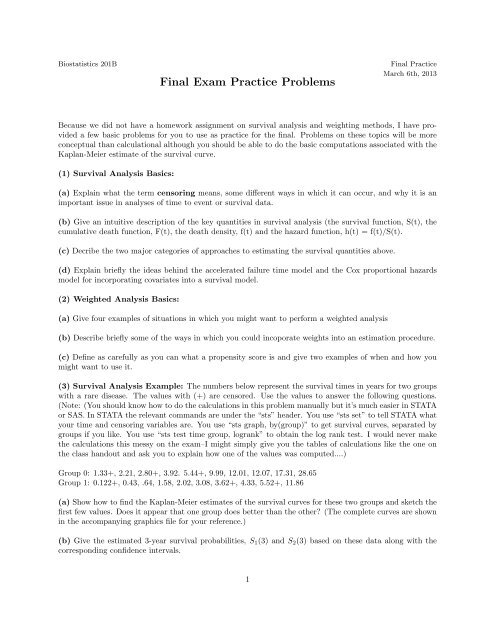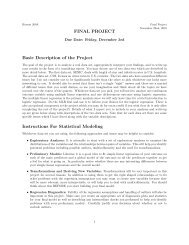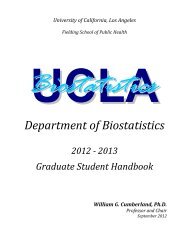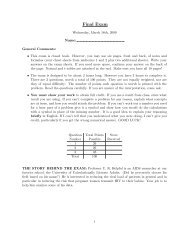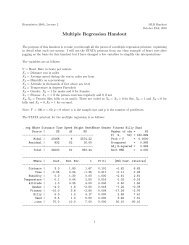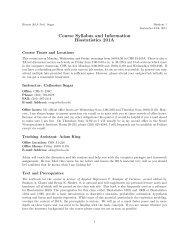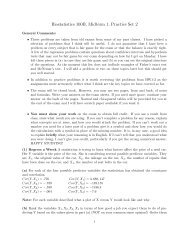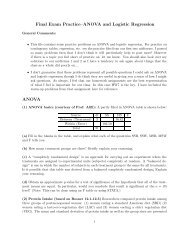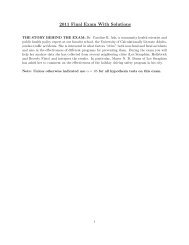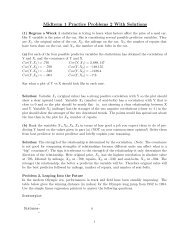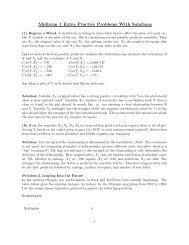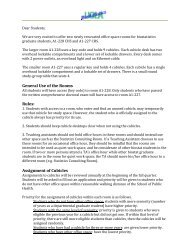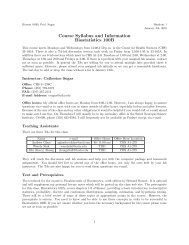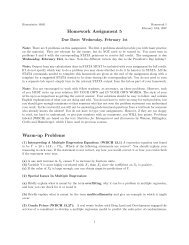Extra practice problems for the final exam. - UCLA Biostatistics
Extra practice problems for the final exam. - UCLA Biostatistics
Extra practice problems for the final exam. - UCLA Biostatistics
You also want an ePaper? Increase the reach of your titles
YUMPU automatically turns print PDFs into web optimized ePapers that Google loves.
<strong>Biostatistics</strong> 201BFinal Exam Practice ProblemsFinal PracticeMarch 6th, 2013Because we did not have a homework assignment on survival analysis and weighting methods, I have provideda few basic <strong>problems</strong> <strong>for</strong> you to use as <strong>practice</strong> <strong>for</strong> <strong>the</strong> <strong>final</strong>. Problems on <strong>the</strong>se topics will be moreconceptual than calculational although you should be able to do <strong>the</strong> basic computations associated with <strong>the</strong>Kaplan-Meier estimate of <strong>the</strong> survival curve.(1) Survival Analysis Basics:(a) Explain what <strong>the</strong> term censoring means, some different ways in which it can occur, and why it is animportant issue in analyses of time to event or survival data.(b) Give an intuitive description of <strong>the</strong> key quantities in survival analysis (<strong>the</strong> survival function, S(t), <strong>the</strong>cumulative death function, F(t), <strong>the</strong> death density, f(t) and <strong>the</strong> hazard function, h(t) = f(t)/S(t).(c) Decribe <strong>the</strong> two major categories of approaches to estimating <strong>the</strong> survival quantities above.(d) Explain briefly <strong>the</strong> ideas behind <strong>the</strong> accelerated failure time model and <strong>the</strong> Cox proportional hazardsmodel <strong>for</strong> incorporating covariates into a survival model.(2) Weighted Analysis Basics:(a) Give four <strong>exam</strong>ples of situations in which you might want to per<strong>for</strong>m a weighted analysis(b) Describe briefly some of <strong>the</strong> ways in which you could incoporate weights into an estimation procedure.(c) Define as carefully as you can what a propensity score is and give two <strong>exam</strong>ples of when and how youmight want to use it.(3) Survival Analysis Example: The numbers below represent <strong>the</strong> survival times in years <strong>for</strong> two groupswith a rare disease. The values with (+) are censored. Use <strong>the</strong> values to answer <strong>the</strong> following questions.(Note: (You should know how to do <strong>the</strong> calculations in this problem manually but it’s much easier in STATAor SAS. In STATA <strong>the</strong> relevant commands are under <strong>the</strong> “sts” header. You use “sts set” to tell STATA whatyour time and censoring variables are. You use “sts graph, by(group)” to get survival curves, separated bygroups if you like. You use “sts test time group, logrank” to obtain <strong>the</strong> log rank test. I would never make<strong>the</strong> calculations this messy on <strong>the</strong> <strong>exam</strong>–I might simply give you <strong>the</strong> tables of calculations like <strong>the</strong> one on<strong>the</strong> class handout and ask you to explain how one of <strong>the</strong> values was computed....)Group 0: 1.33+, 2.21, 2.80+, 3.92. 5.44+, 9.99, 12.01, 12.07, 17.31, 28.65Group 1: 0.122+, 0.43, .64, 1.58, 2.02, 3.08, 3.62+, 4.33, 5.52+, 11.86(a) Show how to find <strong>the</strong> Kaplan-Meier estimates of <strong>the</strong> survival curves <strong>for</strong> <strong>the</strong>se two groups and sketch <strong>the</strong>first few values. Does it appear that one group does better than <strong>the</strong> o<strong>the</strong>r? (The complete curves are shownin <strong>the</strong> accompanying graphics file <strong>for</strong> your reference.)(b) Give <strong>the</strong> estimated 3-year survival probabilities, S 1 (3) and S 2 (3) based on <strong>the</strong>se data along with <strong>the</strong>corresponding confidence intervals.1
(c) Estimate <strong>the</strong> median survival time <strong>for</strong> people in <strong>the</strong>se two groups.(d) Test whe<strong>the</strong>r <strong>the</strong>re is a difference in 3-year survival probability <strong>for</strong> <strong>the</strong>se two groups using (a) a Z-testand (b) a confidence interval <strong>for</strong> <strong>the</strong> difference between <strong>the</strong> survival curves.(e) The printout below shows <strong>the</strong> log-rank test comparing <strong>the</strong>se two groups. Explain what hypo<strong>the</strong>ses arebeing tested and give your real-world conclusions.Log-rank test <strong>for</strong> equality of survivor functions| Events Eventsgroup | observed expected------+-------------------------0 | 7 10.471 | 7 3.53------+-------------------------Total | 14 14.00chi2(1) = 5.51Pr>chi2 = 0.0189(f) Suppose none of <strong>the</strong> observations had been censored. What would your estimates of <strong>the</strong> 3-year survivalprobabilities have been and why?2


